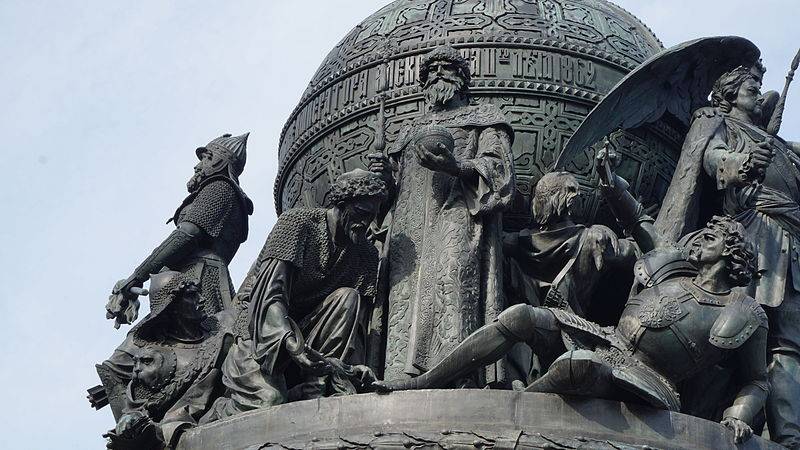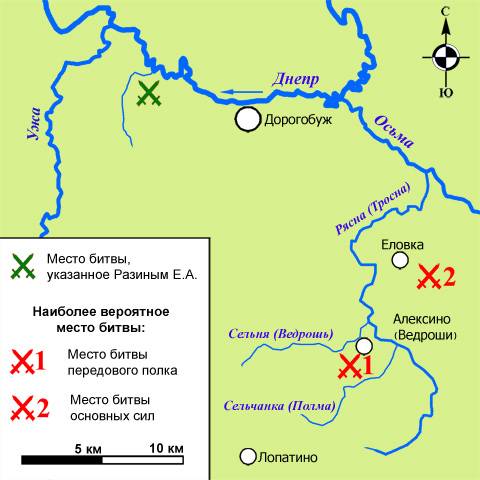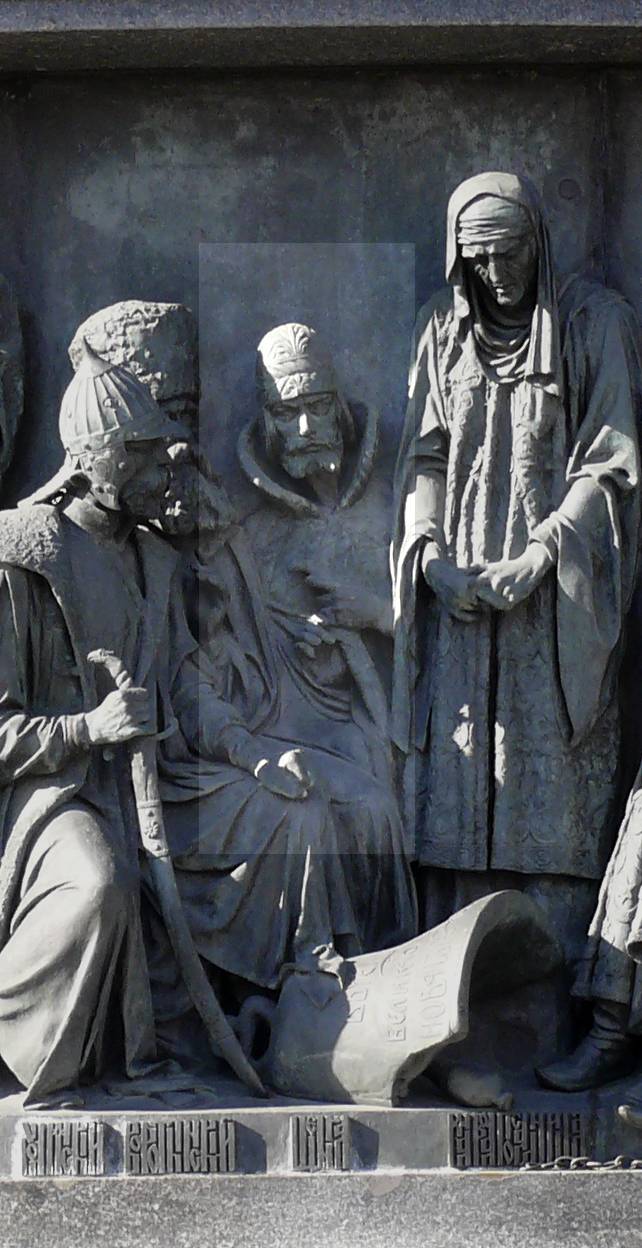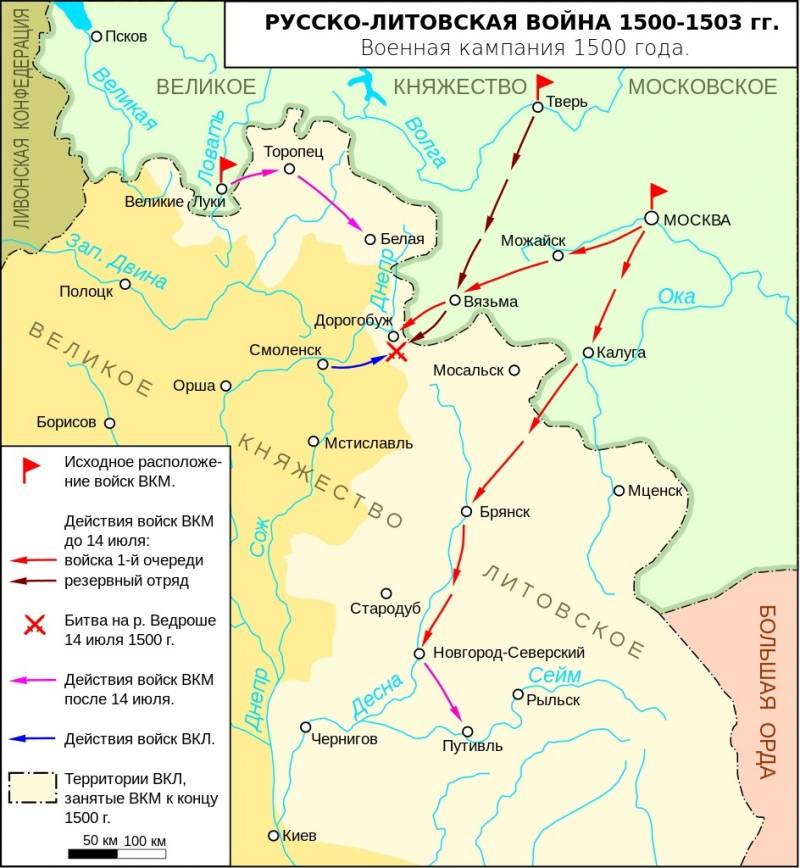The death of the Lithuanian army in the Battle of Vedrosh

On July 14, 1500, the Russian army defeated the Lithuanian troops in the battle on the Vedrosh River. This battle became the peak of the Russian-Lithuanian war of 1500-1503. The Russians destroyed or captured most of the enemy troops. The Lithuanians lost their strategic initiative and were defeated in the war.
Moscow made a profitable peace with Lithuania, occupying almost a third of the possessions of the Principality of Lithuania, including Old Russian Severshchina.
The struggle of two Russian centers
During the period of feudal fragmentation, the collapse of the ancient empire of the Rurikovich there was no single Russian state. Kiev, Ryazan, Moscow, Novgorod, Pskov and other principalities and lands lived on their own, as independent powers. The neighbors took advantage of this. A significant part of the southwestern and western Russian lands were captured by Hungary, Poland and Lithuania. The Grand Duchy of Lithuania included the lands of Little, Black and White Russia, Bryansk, Smolensk and other lands of Russia.
At the same time, the Grand Duchy of Lithuania and Russia was a real Russian state, a competitor to Moscow in the unification of Russian lands. The Principality was ruled by Lithuanian princes. However, the vast majority of lands and population were Russian. A significant part of the elite was Russian in origin. The state and written language was Russian. Lithuanian was spoken only among the lower classes of the ethnic Lithuanian population, although gradually the Lithuanians themselves switched to Russian (as a more developed language). In addition, the Lithuanians barely (in historical terms) stood out from the Balto-Slavic ethno-lingual community, they only recently worshiped Perun and Veles, the gods common with the Russians. That is, the Russians and Lithuanians until recently were one people, with a common spiritual and material culture. And within the framework of a single power they could again become one people.
Lithuania was a powerful military power. From the Horde, a significant part of its border was covered by other Russian lands. There was serious economic potential. The Grand Duchy had a good chance to lead the process of unification of all or most of the Russian lands. However, the Lithuanian elite could not use this opportunity. The Lithuanian elite gradually took the path of Westernization, Polonization and Catholicization. The gentry estate (nobility) became more oppressive, and the peasant communities enslaved according to the Polish model, turned into slave-claps. This caused a deep split between the elite and the people. As a result, Moscow, which was initially weaker in the military-economic respect and in terms of human resources, the Russian state, took up and became the center of the unification of the Russian land (Russian world civilization).
Situation before the war
During the reign of Ivan III Vasilyevich (1462-1505), Moscow went on the offensive. The stage of "collecting Russian lands" began. Ivan strengthened allied relations with Tver, Ryazan and Pskov. The Yaroslavl, Dmitrov and Rostov principalities lost their independence. Many princes became “servants,” subordinate to the grand duke. Moscow crushed the Novgorod veche republic. In 1478, Novgorod surrendered, its "independent" orders were abolished. Mastering the North, Moscow subjugated Perm, Ugra and Vyatka. Ivan the Great challenged the Horde, which decomposed and was in a period of collapse. In fact, Moscow was already completely independent and paid tribute according to the old tradition. In 1480, this tradition was eliminated. The previously powerful Horde quickly collapsed, and Moscow began to pursue an offensive policy in the east and south, becoming the new center of the new Eurasian (northern) empire.
The most important tool for the active and successful policy of Moscow was the army, which underwent significant changes. A local army was created - a large noble militia. Large-scale military production, including cannon-foundry, has been established. The increased military potential, due to the political and economic strengthening of the state and the actions of the sovereign, made it possible to successfully repel raids and invasions of hordes on the southeastern borders, exert political influence on Kazan, the Crimea and other fragments of the Horde, expand its possessions in the northeast, and successfully fight The Grand Duchy of Lithuania, the Livonian Order and Sweden for the restoration of our natural borders in the north, northwest and west.
It is clear that the desire of Moscow to "gathering land" ran into resistance to Lithuania. Moscow thwarted attempts by Novgorodians to come under the rule of the Grand Duchy. In 1480, the Horde entered into an alliance with Lithuania, directed against Moscow. In turn, Moscow "was friends" with the Crimean Khanate against Lithuania. Part of the nobility of the Grand Duchy begins to look in the direction of the Moscow sovereign, to switch to the side of Moscow. Skirmishes at the border become constant. Their cause was border-territorial disputes. Moscow did not recognize the right of Lithuania to own the cities of Kozelsky, Serensky and Khlepnyom, sought to subjugate the Verkhov princes, who passed under the rule of the Lithuanian prince under Vasily the Second. After the submission of Veliky Novgorod, another controversial question arose - about the "Rzhev tribute." Moscow forces occupy a number of border volosts, which were initially jointly owned by Moscow-Lithuanian (or Novgorod-Lithuanian). Thus began the Russo-Lithuanian war of 1487-1494, the “strange war” (officially both powers were at peace throughout the conflict).
Throughout the world in 1494, most of the land occupied by Russian troops was part of the power of Ivan the Great. Including the strategically important Vyazma fortress. The cities of Lubutsk, Mezetsk, Mtsensk and some others returned to Lithuania. The Grand Duchy refused claims to the "Rzhev tribute." Also, the consent of the Russian sovereign to the marriage of his daughter Elena with the Grand Duke of Lithuania Alexander was obtained. In addition, it was forbidden to take fugitive service princes along with the estates.
Reason for a new war
The 1494 Treaty was considered by both parties to be temporary. The Lithuanian government longed for revenge. Moscow, seeing the enemy’s weakness, planned to continue the struggle for the return of the “Grand Duchy of Kiev”. The western border was still not precise, which created a source of new border disputes and conflicts that continued until the new war.
In 1497, the war between Moscow and Sweden ended, the peace was concluded very on time. A new war has ripened with Lithuania. Angered by the desire to convert his daughter Elena to Catholicism, the Moscow sovereign again begins to accept the princes who left the Lithuanian service. In April 1500, Simon Belsky, Vasily Shemyachich and Semyon Mozhaysky, who owned huge estates on the eastern outskirts of the Grand Duchy of Lithuania with the cities of Belaya, Novgorod-Seversky, Rylsk, Radogoshch, Starodub, Gomel, Chernigov, Karachev, Khotiml, came under Moscow’s rule. War has become inevitable.
On the eve of the war, the Grand Duke of Lithuania Alexander Kazimirovich took a number of steps to strengthen his military-political position. In July 1499, the conclusion of the Gorodel Union between the Grand Duchy and Poland took place. Lithuania's ties with Livonia and the Great Horde (Khan Sheikh-Akhmet) were also strengthened. However, neither Poland, nor Livonia, nor the Great Horde were able to provide immediate military assistance to Lithuania.
The defeat of Lithuania
Taking advantage of the favorable foreign policy situation, the great Moscow sovereign began the war. The Russian army acted according to a predetermined plan. On the eve of the war, three rati were formed: in the Toropetsk, Smolensk and Novgorod-Seversky directions. Also, part of the army was in reserve to assist the rati, where the main enemy forces would be discovered.
On May 3, 1500, from Moscow to the Lithuanian border, a army came under the command of the Kazan exile khan Mohammed-Emin and Yakov Zakharyich (Koshkin-Zakharyin) who served Ivan the Great. The Russian army captured Mtsensky, Serpeysky, Bryansk, and together with the troops of Semyon Mozhaysky and Vasily Shemyachich, in August occupied Putivl.
In other areas, the Russian offensive was also successful. The army composed of Novgorodians under the command of the governor Andrey Chelyadnin, reinforced by regiments of the specific princes Volotsky, took possession of Toropets. Another army under the command of the governor Yuri Zakharyich (brother of Jacob Zakharyich) took possession of Dorogobuzh. There was a threat of Moscow rati coming to Smolensk. The successful offensive of the Russian army alarmed Alexander Kazimirovich and his entourage. A hasty mobilization was carried out, the Lithuanian counterattack was expected from Smolensk to Dorogobuzh. To Dorogobuzh from the Tver region, an army was urgently transferred under the supervision of the experienced governor Daniil Scheni. He connected with the detachment of Yuri Zakharyich and took command of the entire army. Its number reached 40 thousand fighters.
As subsequent events showed, the decision to advance the reserve under the leadership of one of the best generals of Russia near Dorogobuzh was correct. From Smolensk through Yelnya the 40th Lithuanian army moved under the command of the hetman of the Lithuanian prince Konstantin Ostrozhsky. Estimating the number of troops of each side in 40 thousand soldiers seems to be overestimated to one degree or another, but on the whole the forces of the parties were approximately equal. Both armies met in the area of the rivers Trosny, Vedroshi and Selchanka. On July 14, 1500, a decisive battle took place between them, which became the main event of the entire war.
Before the battle, the Russian army was located in its camp on Mitkovoye field, 5 km west of Dorogobuzh, beyond the Vedrosh river. The only crossing in these places was thrown across the Bucket. Intelligence in time reported on the approach of the enemy. The Russian governors, without intentionally destroying the bridge, prepared the troops for battle. The main forces were the Great Regiment of Puppies. The right flank was covered by the Dnieper, at the confluence of the r. Ropes, left - closed by a large impassable forest. An ambush regiment, the Watchtower Regiment of Yuri Zakharyich, was located in the forest. On the west coast, the Vedroshi advanced a forward detachment, which was to start a battle and lure the enemy to the other shore, where our main forces were waiting for him.
Unlike the Moscow governor, the hetman of Ostrog went to the place of the future battle without complete information about the enemy. He had approximate information of prisoners and defectors. And he believed that in front of him was only a small Russian army. Therefore, the Lithuanians immediately overturned the advanced Russian regiment and crossed the river, where they cut into the ranks of the Big Regiment. The stubborn battle lasted several hours. The outcome was decided by the strike of the Ambush Regiment. Russian troops went to the rear of the Lithuanians, destroyed the bridge and cut off the path to retreat. After that, the beating of a fallen enemy in spirit began. Only the killed Lithuanians lost about 8 thousand people. Many drowned during the flight or were captured, including the hetman of Ostrog and other governors. Also, all artillery and carts of the enemy became Russian trophies.

War with livonia
In the battle on the Vedrosh River, the main and most combat-ready forces of the Lithuanian army were destroyed and captured. The Grand Duchy lost its offensive capabilities and switched to defense. Only the aggravation of the situation on the other borders of the Russian state saved Lithuania from further defeats.
Russian victories alarmed other opponents of Moscow. Most feared Livonians who decided to stand on the side of the Grand Duchy. In the spring of 1501, Russian merchants were arrested in Derpt-Yuriev, their goods looted. The Pskov ambassadors sent to Livonia were detained. In June 1501, the military alliance of Lithuania and Livonia was signed. Clashes began on the northwestern border. In August 1501, the army of the Livonian magister Walter von Plettenberg launched an invasion of the lands of Pskov. On August 27, the Livonians defeated the Russian army (regiments from Novgorod, Pskov and Tver) on the Seritsa River.
The Livonians besieged Izborsk, but could not take it in stride. Then the Order of the army marched on Pskov. On September 7, the Livonians besieged the small island fortress. On the night of September 8, a night assault began, during the battle the entire population of the town died - 4 thousand people. However, having taken the fortress, the Livonians could not develop their first successes and hastily retreated to their territory. An epidemic has begun in the army. The master himself became ill. In addition, the Livonian command did not dare to continue the offensive in the face of stubborn resistance of the Russians and the lack of support from the Lithuanians. The Grand Duke Alexander promised the master assistance in the attack on Pskov, but allocated only a small detachment, and he was too late. The fact was that in Poland, King Jan Olbracht (brother of the Grand Duke Alexander) died, and Alexander went to the Sejm, where they elected a new monarch. Alexander Kazimirovich was elected the new Polish king.
Moscow skillfully took advantage of the inconsistency of its opponents and in the fall of 1501 it struck back at Livonia. A large army was advanced to the northwestern borders of Russia under the leadership of Daniel Scheni and Alexander Obolensky. It also included Tatar units of Khan Muhammad-Emin. The Grand Duke’s army joined Pskov and invaded Livonia. The eastern lands of the Order, especially the possessions of the Dorpat bishopric, were severely devastated. The master counterattacked in the Dorpat area. At first, due to the factor of surprise, the Livonians pressed the Russians, the governor Obolensky died. But then the Russians and the Tatars came to their senses and went on the offensive, the order army suffered a crushing defeat. The persecution and beating of escaped Livonian warriors lasted about 10 miles. The core of the Livonian army was destroyed.
In the winter of 1501-1502 Puppy's army again made a campaign in Livonia, in the direction of Revel-Kolyvan. Livonia was again devastated. Having mobilized new forces in the spring of 1502, the Livonians again went on the offensive. One German detachment attacked Ivangorod, the other a small Pskov fortress Red Town. Both attacks of the Livonians failed, the enemy hastily retreated. In the fall of 1502, at the height of the siege of Smolensk launched by the Russian troops, the Livonians launched another attack on Pskov to help the Lithuanians. Master Plettenberg besieged Izborsk. The assault of Izborsk failed, then the Germans marched on Pskov. Attempts to destroy the walls with artillery failed. Upon learning of the approach of the Russian troops from Novgorod, they were led by the governors of Shchen and Shuysky, the Germans hastily retreated to their territory.
In the struggle against Moscow, in addition to Livonia, the last khan of the Great Horde, Sheikh-Ahmed, also helped the Grand Duchy of Lithuania. In the fall of 1501, his troops attacked Seversky land, ravaged Rylsk and Novgorod-Seversky, ravaged the surroundings of Starodub. Separate detachments reached Bryansk. This distracted part of the forces of the great Moscow sovereign.

Return of Severshchina
Despite the support of Livonia and the Great Horde, Lithuania lost the war. Already in the fall of 1501, the Moscow governors launched a new offensive inland of Lithuanian territory. In November, Russian troops defeated the Lithuanians in the area of Mstislavl. Lithuanians lost about 7 thousand people. True, Mstislavl himself could not be taken. At that time, the Tatars of the Great Horde attacked Severshchina. These were the estates of Vasily Shemyachich and Semyon Mozhaysky, and they rushed to defend their possessions. Meanwhile, the troops of Sheikh Ahmed were attacked by the Crimean horde, and they were defeated. The Great Horde has fallen.
In the summer of 1502, Russian troops tried to take Smolensk, but without success. After that, the Russian governors changed their tactics. They no longer sought to besiege the fortresses, but simply devastated Lithuanian lands. Lithuania, unable to continue the war, like Livonia, asked for peace. On March 25, 1503, the Annunciation Truce was concluded for a period of six years. 19 cities went to the Russian state, including Chernigov, Starodub, Putivl, Rylsk, Novgorod-Seversky, Gomel, Lubech, Pochep, Trubchevsk, Bryansk, Mtsensk, Serpeysk, Mosalsk, Dorogobuzh, Toropets and others. The Grand Duchy of Lithuania also lost 70 volosts, 22 settlements and 13 villages, that is, about a third of their territory.
It was a great success for the Russian weapons and diplomacy in the collection of Russian lands. Russia also received military-strategic positions: the new border passed in the region of about 50 km from Kiev and 100 km from Smolensk. The resumption of the struggle for the creation of a single Russian state was inevitable. Sovereign Ivan the Great himself was aware of this and was preparing for the return of all "his homeland, all Russian land," including Kiev.
- Alexander Samsonov
- https://ru.wikipedia.org/


Information